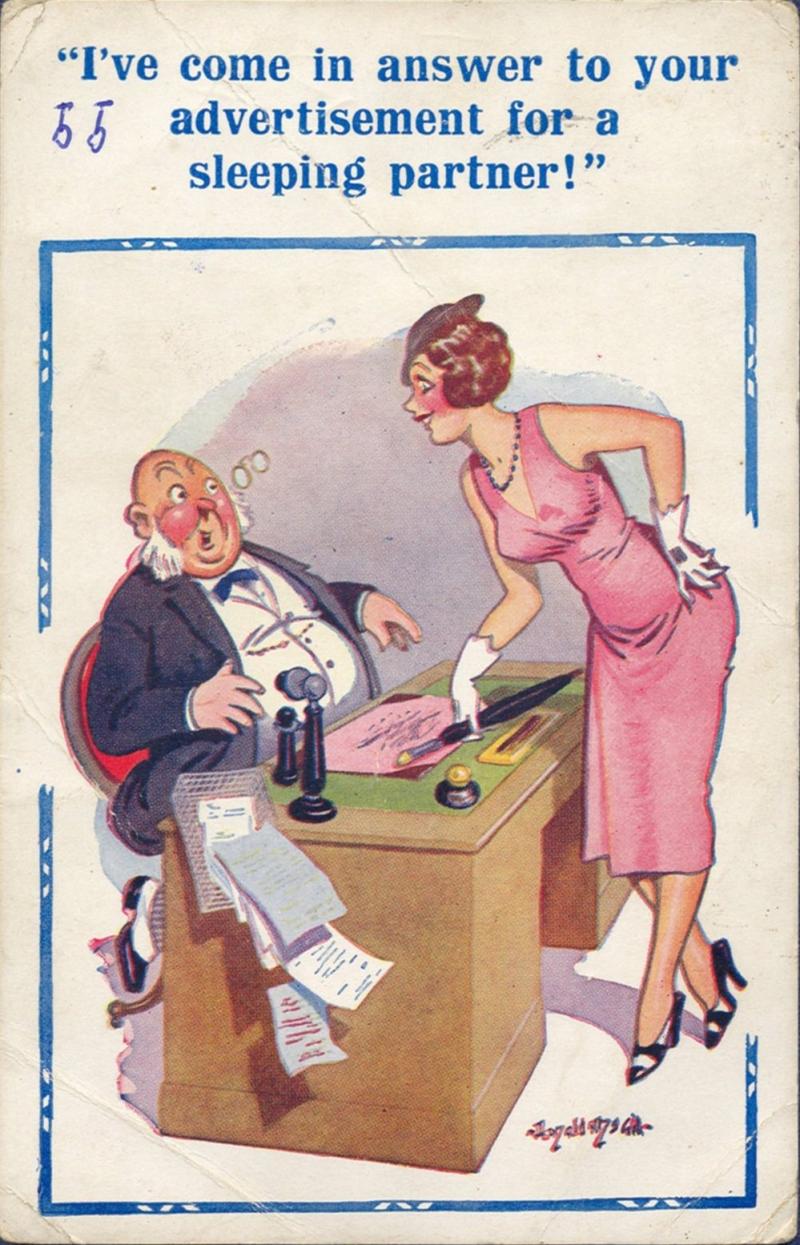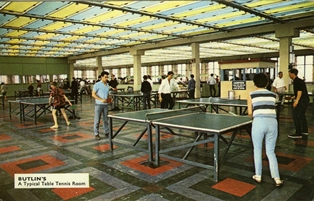Timeshift: The Picture Postcard World of Nigel Walmsley, BBC Four | reviews, news & interviews
Timeshift: The Picture Postcard World of Nigel Walmsley, BBC Four
Timeshift: The Picture Postcard World of Nigel Walmsley, BBC Four
Butlin’s recruited expert German photographers to take images of their facilities in high-contrast colour

Declaring that “everything in the world exists to end up on a postcard” is pretty courageous. But after watching the charming, gently funny Picture Postcard World of Nigel Walmsley you begin thinking that maybe, just maybe, everything was created to be depicted on a piece of card destined to be sent through the post. Holiday camps, motorways, hills, walls - all were created to become images printed on the postcards collected by deltiologists like Ronnie Barker and Michael Winner.
A deltiologist is a postcard collector. Michael Winner, who appeared here, is already well known to theartsdesk for his love of Donald McGill's postcards. Glbert and George though, have a slightly different take on postcards. All the postcard fan's needs are serviced by Reflections, The Picture Postcard Monthly. Fairs sell just postcards. Books like Tom Phillips’s The Postcard Century and Martin Parr’s Boring Postcards celebrate the world of “pictures on the front, writing on the back”. All much like any other collectable then, be it records, model cars, or teddy bears.
But postcards are different. As the fictitious and largely unseen Bristolian Nigel Walmsley travelled through the world of postcards, boning up before an equally bogus talk he’d been invited to give, their unique social and sociological aspects emerged.
On the morning of 19 July 1909 a train crashed at Croydon. Photos of the disaster were instant postcard fodder. The cards survive, and bear the postmark of that day. In pre-World War I Britain, with up to seven postal deliveries a day, a postcard sent in the morning could reach its destination the same day. Not quite text messaging or e-mail, but amazing for a world before the telephone became a household object.
We soon found out that postcards, of course, were more than news bulletins. They caught on quickly after emerging in Germany in the 1870s. Shops were dedicated to selling postcards. In 1902, 350 million were sent in Britain. In 1906, it was 700 million. The figures slacken off after World War I with the arrival of the phone, so the Edwardian era was repeatedly referred to as the postcard’s Golden Age. Stamps prices rose after 1918, the telephone arrived and the Golden Age was over. Another boom from the 1950s to 1970s came with post-WWII affluence, the increased taking of holidays and the need to let your family and relatives know that you wished they were here, the boarding house bed was lumpy and yah-boo, we’re here, you’re not. .
 They were also a promotional tool. Holiday camp chain Butlin’s recruited expert German photographers to take staged images, showing off their facilities in high-contrast colour. Hyper-real, these pictures share psychedelia’s altered reality. Less attractive perhaps, but equally appealing to photographer Martin Parr, are postcards of motorways – including an empty M1. He was taken there as a treat when he was a kid.
They were also a promotional tool. Holiday camp chain Butlin’s recruited expert German photographers to take staged images, showing off their facilities in high-contrast colour. Hyper-real, these pictures share psychedelia’s altered reality. Less attractive perhaps, but equally appealing to photographer Martin Parr, are postcards of motorways – including an empty M1. He was taken there as a treat when he was a kid.
Postcards were occasionally notorious too. The king of the sauce and smut, Donald McGill, was the first full-time postcard artist and now has a dedicated museum on the Isle of White. Back in 1954, however, he was recognised in a different way and prosecuted for his double entendres straying too close to single meanings. Sales didn’t suffer. The Isle of Man and Blackpool had Postcard Censoring Committees which vetted the next season’s offerings. Cameras peaked in on their meetings. It wasn’t said how they cooled off after rigorous examination of one smutty card after another.
But the postcards themselves has personal stories as well. It was possible to visit a studio, have a portrait taken and purchase a dozen or more of yourself. As put here, this was the democratisation of the portrait. Postcards were seen by all after being mailed, so scribblers developed codes and wrote in allusion about entering tunnels, whatever that means. A tilted stamp was an emoticon, denoting affection
No wonder then that Ronnie Barker, Michael Winner and Andrew Sachs - all of whom cropped up: not many female deltiologists around – were attracted to the postcard’s manifold aspects. More ironic was the appearance of blogger Guy Atkins, representing the medium which ensures there’ll never be another Golden Age for the postcard.
The Picture Postcard World of Nigel Walmsley did more than bring the postcard into the living room. It invited you – made you - want to get out, find a second-hand shop, go to a fair and start rummaging around for these artefacts, with their mysterious messages and tantalising images of lost worlds.
- Watch The Picture Postcard World of Nigel Walmsley on BBC iPlayer
The future of Arts Journalism
You can stop theartsdesk.com closing!
We urgently need financing to survive. Our fundraising drive has thus far raised £49,000 but we need to reach £100,000 or we will be forced to close. Please contribute here: https://gofund.me/c3f6033d
And if you can forward this information to anyone who might assist, we’d be grateful.

Subscribe to theartsdesk.com
Thank you for continuing to read our work on theartsdesk.com. For unlimited access to every article in its entirety, including our archive of more than 15,000 pieces, we're asking for £5 per month or £40 per year. We feel it's a very good deal, and hope you do too.
To take a subscription now simply click here.
And if you're looking for that extra gift for a friend or family member, why not treat them to a theartsdesk.com gift subscription?
more TV
 Mr Scorsese, Apple TV review - perfectly pitched documentary series with fascinating insights
Rebecca Miller musters a stellar roster of articulate talking heads for this thorough portrait
Mr Scorsese, Apple TV review - perfectly pitched documentary series with fascinating insights
Rebecca Miller musters a stellar roster of articulate talking heads for this thorough portrait
 Down Cemetery Road, Apple TV review - wit, grit and a twisty plot, plus Emma Thompson on top form
Mick Herron's female private investigator gets a stellar adaptation
Down Cemetery Road, Apple TV review - wit, grit and a twisty plot, plus Emma Thompson on top form
Mick Herron's female private investigator gets a stellar adaptation
 theartsdesk Q&A: director Stefano Sollima on the relevance of true crime story 'The Monster of Florence'
The director of hit TV series 'Gomorrah' examines another dark dimension of Italian culture
theartsdesk Q&A: director Stefano Sollima on the relevance of true crime story 'The Monster of Florence'
The director of hit TV series 'Gomorrah' examines another dark dimension of Italian culture
 The Monster of Florence, Netflix review - dramatisation of notorious Italian serial killer mystery
Director Stefano Sollima's four-parter makes gruelling viewing
The Monster of Florence, Netflix review - dramatisation of notorious Italian serial killer mystery
Director Stefano Sollima's four-parter makes gruelling viewing
 The Diplomat, Season 3, Netflix review - Ambassador Kate Wyler becomes America's Second Lady
Soapy transatlantic political drama keeps the Special Relationship alive
The Diplomat, Season 3, Netflix review - Ambassador Kate Wyler becomes America's Second Lady
Soapy transatlantic political drama keeps the Special Relationship alive
 The Perfect Neighbor, Netflix review - Florida found-footage documentary is a harrowing watch
Sundance winner chronicles a death that should have been prevented
The Perfect Neighbor, Netflix review - Florida found-footage documentary is a harrowing watch
Sundance winner chronicles a death that should have been prevented
 Murder Before Evensong, Acorn TV review - death comes to the picturesque village of Champton
The Rev Richard Coles's sleuthing cleric hits the screen
Murder Before Evensong, Acorn TV review - death comes to the picturesque village of Champton
The Rev Richard Coles's sleuthing cleric hits the screen
 Black Rabbit, Netflix review - grime and punishment in New York City
Jude Law and Jason Bateman tread the thin line between love and hate
Black Rabbit, Netflix review - grime and punishment in New York City
Jude Law and Jason Bateman tread the thin line between love and hate
 The Hack, ITV review - plodding anatomy of twin UK scandals
Jack Thorne's skill can't disguise the bagginess of his double-headed material
The Hack, ITV review - plodding anatomy of twin UK scandals
Jack Thorne's skill can't disguise the bagginess of his double-headed material
 Slow Horses, Series 5, Apple TV+ review - terror, trauma and impeccable comic timing
Jackson Lamb's band of MI5 misfits continues to fascinate and amuse
Slow Horses, Series 5, Apple TV+ review - terror, trauma and impeccable comic timing
Jackson Lamb's band of MI5 misfits continues to fascinate and amuse
 Coldwater, ITV1 review - horror and black comedy in the Highlands
Superb cast lights up David Ireland's cunning thriller
Coldwater, ITV1 review - horror and black comedy in the Highlands
Superb cast lights up David Ireland's cunning thriller
 Blu-ray: The Sweeney - Series One
Influential and entertaining 1970s police drama, handsomely restored
Blu-ray: The Sweeney - Series One
Influential and entertaining 1970s police drama, handsomely restored

Add comment